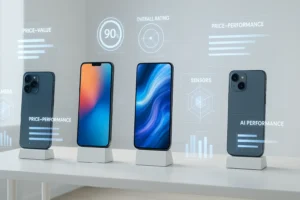Smart TVs have evolved significantly, offering cutting-edge display technologies, superior sound systems, and smart features that enhance entertainment experiences. With multiple brands and models available, choosing the perfect TV can be overwhelming. This guide provides an in-depth comparison of the best smart TVs in 2025, analyzing key specifications such as display technology, resolution, refresh rate, HDR support, smart features, connectivity, audio quality, and pricing. By the end, you’ll have a clear understanding of which TV suits your needs best, whether for gaming, movies, sports, or general entertainment.
Looking for the best speaker systems to complement your smart TV? Check out our detailed guide on Top Speaker Systems to enhance your home entertainment setup.
Best Smart TV Display Technologies: OLED vs. QLED vs. Mini-LED vs. LED
OLED (Organic Light-Emitting Diode) TVs
- Pros: Perfect blacks, infinite contrast, excellent color accuracy, ultra-fast response times.
- Cons: Expensive, risk of burn-in, slightly lower brightness compared to QLED.
- Best For: Movie enthusiasts, gamers who value deep blacks and fast response times.
QLED (Quantum Dot LED) TVs
- Pros: Brighter than OLED, excellent color reproduction, no burn-in risk.
- Cons: Inferior black levels compared to OLED, lower contrast.
- Best For: Bright room viewing, sports, general use.
Mini-LED TVs
- Pros: High brightness, improved black levels compared to standard LED, better local dimming.
- Cons: Not as contrast-rich as OLED, slightly expensive.
- Best For: Balanced performance across all content types.
LED (Light-Emitting Diode) TVs
- Pros: Affordable, widely available, decent brightness levels.
- Cons: Lower contrast, limited viewing angles, inferior color accuracy.
- Best For: Budget-conscious buyers, casual viewers.
4K vs. 8K Resolution: Which One Should You Choose?
- 4K (3840 × 2160 pixels): Standard for modern smart TVs, delivering excellent sharpness.
- 8K (7680 × 4320 pixels): Superior detail and clarity, but limited content availability and high price.
- Best Choice: 4K remains the best option for most buyers, while 8K is future-proof but expensive.
Best Refresh Rate for Smart TVs: 60Hz vs. 120Hz vs. 144Hz
- 60Hz: Suitable for standard TV viewing.
- 120Hz: Ideal for gaming and fast-motion sports.
- 144Hz: Found in high-end gaming TVs for ultra-smooth motion.
- Best For: Gamers and sports enthusiasts should opt for 120Hz or higher.
HDR Support: HDR10, HDR10+, Dolby Vision, HLG
- HDR10: Standard format, widely supported.
- HDR10+: Dynamic metadata improves brightness and contrast scene-by-scene.
- Dolby Vision: Premium format with superior dynamic range and color depth.
- HLG (Hybrid Log-Gamma): Ideal for broadcast HDR content.
- Best Choice: Dolby Vision for best HDR experience; HDR10+ as a good alternative.
Best Smart TV Operating Systems: Google TV, WebOS, Tizen, Fire TV
- Google TV: Extensive app library, voice assistant integration, Chromecast support.
- WebOS (LG): User-friendly, smooth interface, good app selection.
- Tizen (Samsung): Fast and efficient, with exclusive Samsung features.
- Fire TV: Amazon-centric, budget-friendly, Alexa-enabled.
- Best Choice: Google TV and WebOS for versatility; Tizen for Samsung loyalists.
Smart TV Connectivity: Essential Features to Look For
- HDMI 2.1: Required for next-gen gaming (4K@120Hz, VRR, ALLM).
- Wi-Fi 6: Faster and more stable streaming.
- Bluetooth: Useful for wireless audio devices.
- USB Ports & Ethernet: Essential for additional connections and wired internet.
- Best For: Gamers should prioritize HDMI 2.1; streaming enthusiasts should look for Wi-Fi 6 support.
Best Smart TVs for Sound Quality: Dolby Atmos & DTS:X
- Dolby Atmos: Immersive 3D surround sound.
- DTS:X: Alternative to Dolby Atmos, great for home theaters.
- Built-in Subwoofers: Enhance bass performance.
- Best For: Home theater setups should opt for Dolby Atmos; soundbars can supplement TVs with weak speakers.
Price Comparison of the Best Smart TVs in 2025
| TV Model | Display Type | Resolution | Refresh Rate | HDR Support | Smart OS | Price (Approx.) |
|---|---|---|---|---|---|---|
| LG C3 OLED | OLED | 4K | 120Hz | Dolby Vision | WebOS | $1,800 |
| Samsung QN90C | QLED | 4K | 120Hz | HDR10+ | Tizen | $1,700 |
| Sony A95L | QD-OLED | 4K | 120Hz | Dolby Vision | Google TV | $2,500 |
| TCL 6-Series | Mini-LED | 4K | 144Hz | Dolby Vision | Google TV | $1,200 |
| Hisense U8K | Mini-LED | 4K | 144Hz | Dolby Vision | Google TV | $1,100 |
| Samsung QN900C | QLED | 8K | 120Hz | HDR10+ | Tizen | $4,000 |
Final Verdict: Which Smart TV Should You Buy in 2025?
Choosing the best smart TV depends on your usage requirements and budget. If you seek the best cinematic experience, LG C3 OLED is a top-tier choice. Gamers should consider the TCL 6-Series or LG C3 OLED for high refresh rates and HDMI 2.1 support. Those needing a bright TV for well-lit rooms should look at Samsung QN90C. For an all-around great TV at an affordable price, Hisense U8K is the best deal.
By understanding these key factors and matching them with your personal needs, you can make an informed decision and invest in the perfect smart TV that enhances your viewing experience in 2025.

